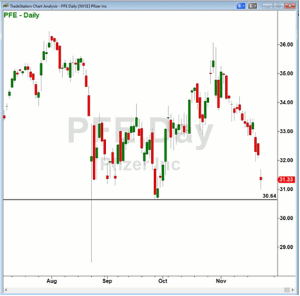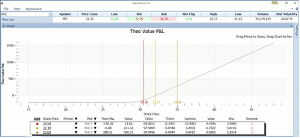Citing a recent merger announcement as an example, options instructor Russ Allen, of Online Trading Academy, points out that—in addition to trades based on where they think the price of a stock is going to go—options traders can also make trades based on where they think the stock is not going to go within a short time.
With every kind of trading, we enter each position with an expectation of which way the price of the instrument is going to move. We make money if we are right or lose money if we are wrong.
With options trading, we can make many trades that work that way too. But in addition to trades based on where we think the price of a stock is going to go, we can also make trades based on where we think the stock is not going to go within a short time. We can make a trade that’s based on a stock’s moving in the direction that we expect or a different trade based on the stock’s not moving in the opposite direction.
For example, look at this chart of Pfizer, Inc. (PFE), as of November 23, 2015:
Pfizer recently announced a merger with a somewhat smaller pharmaceutical company, Allergan (AGN). The transaction is structured as an acquisition of Pfizer by Allergan, when, in fact, it is the other way around. Setting up the deal this way saves corporate taxes since Allergan is based in Ireland where corporate tax rates are just 12.5%. Pfizer expected to reduce its overall corporate income tax rate from 25% to 18% by this move.
In most acquisition scenarios, the stock of the acquiring company goes down and that of the to-be-acquired company goes up after the merger announcement. The acquired company always must be purchased at a premium to its market value and the acquiring company is taking on risks and costs in connection with the deal. The acquiring company, of course, expects these costs to more than be made up by future earnings and cost savings as overlapping assets and people of the combined entity can be eliminated. This acquiree-up-acquirer-down movement seems to have happened recently as Allergan’s stock went up and Pfizer’s went down.
From a technical standpoint, PFE was near a low at $30.64 where we could expect some demand to support the price.
If we believed that the shock of the acquisition news was already absorbed and that PFE would be most likely to stabilize and go up from here, we could act on that in one of two ways: we could either take a trade based on the belief that PFE was going to go up or one based on the belief that it was not going to go down.
First, let’s look at the more aggressive options trading scenario, a trade that will pay if PFE goes up.
The simplest way to play this would be to buy call options. Say we believed that PFE could regain its recent highs around 35.00 within a month. We could buy calls at the $30 strike with a February expiration for about $2.12 per share, $212 per option contract. Here is what the profit picture would look like one month from now. Stock price is shown on the horizontal axis. Profit/loss is shown on the vertical axis. All values assume no change in implied volatility in the next month.
NEXT PAGE: What if the Stock Dropped?
|pagebreak|If we planned to exit from the trade in case the stock dropped below our stop-loss price of $30.50, our loss at that point would be about $140 since the value of the call would be $72 in that case. A probability calculator showed about a 32% chance (based on PFE’s volatility) that PFE would be lower than $30.50 in a month.
Our break-even price would be $32.10. If PFE were to be below that price a month from now, we would have a loss; above that, a profit. There was about a 34% chance of finishing above that price, therefore about a one-in-three chance of making a profit.
If the stock hit our $35.00 target, the value of the call would be $500, which would be a gain of $288 from our $212 cost, a 136% profit. Our upside profit would be technically unlimited and we would have the option of leaving the position in place and trailing a stop-loss order if PFE was very strong. The probability of PFE reaching $35.00 in a month was shown at about 3%.
Note that the above probability estimates were based on the recent volatility of the stock. The formula that calculates them is also based on the idea that stock price movements are completely random. Since we do not believe that to be the case—and that some kinds of movement are more likely than others—to the extent that we are correct in those beliefs our probabilities of profit are greater than those shown by the calculator.
So, with this trade the potential returns were very good. However, we would need the stock to move up to at least $32.10 in order not to lose money, which only had about a one-in-three chance of happening.
Next, let’s check out the trade we could have made that was based not on the idea that PFE would go up, but on the belief that it would not go down.
We could have sold December puts at the $30 strike for about $.32 a share. This $32 sale price for the contract would be our maximum profit. If—when these expired in a month—PFE were to be anywhere above $30, the puts would expire worthless and we would retain the full $32 as profit. We would have a lesser amount of profit as long as the stock didn’t drop below the $30 strike by more than the $.32 that we received for the options at the December options expiration. Our breakeven price was $30 – $.32 = $29.68.
Again, using the probability calculator, we found that the chances of PFE being above $30 were about 77% and the probability of being above our $29.68 break-even was about 82%. That means that the probability of showing a loss on this trade was just 18%.
So there you have it. The aggressively bullish trade, betting that the stock would go up (buying the calls), could make far more money but required that the stock move up substantially in order to not actually lose money. The neutrally bullish trade, betting that the stock would not go down (selling puts), could make far less money but it had a very high probability of success. Our confidence in the price movement would partly determine which of these trades made the most sense to us.
There is one other factor that would enter into our decision as to which of these trades to take. That factor is the level of inflatedness of the options, the extent to which options were either cheaper or more expensive than normal. We’ll cover that aspect next time.
By Russ Allen, Instructor, Online Trading Academy























